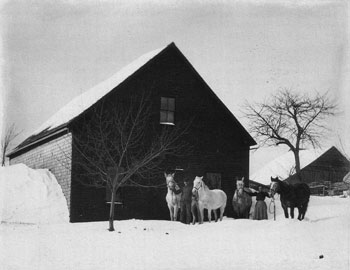B A C K T H E N
The Key Element

Early 1900s. A mammoth snowdrift bank the south side of the barn on an unknown farm, photographed by Charles Cook, a Unity farmer. There are sledloads of firewood in the background dooryard; winter was the season for woods work. A young apple tree stands in the foreground.
Any farmer would immediately spot the key element to this tableau—the woman holding two horses. Most likely she is the farmer's wife, but she could also be a spinster sister living with her bachelor brother. Given the apparent closeness of their ages, she probably isn't a housekeeper. In any case, she is apparently the farmer's helpmate, and likely works the longer hours of the two.
While solitary farming might have been preferable to marriage to a nagging old rip—just as life as a spinster, while rarely easy, was surely preferable to entrapment by a rustic despot—it could not, in the end, truly succeed.
Of the 1892 suicide by hanging of a young, single Temple farmer, the June 27, 1892, Kennebec Journal reported that it was thought “that the responsibility of conducting so large a farm alone discouraged him, and he took this method to rid himself of it.” An “old batch” Whitefield farmer of the 1900s left his drafty Italianate farmhouse on cold nights and slept between his oxen in the barn.
In 1904 a speaker from New Hampshire addressed a convention of Maine farmers:
If I could leave but one word of advice with the old, cynical, incrustrated bachelors and widowers, it would be to give tghe flying darts of Cupid just half a chance. The woman makes the home. The farmer’s home begins with a woman and ends with a woman, May God bless her!
